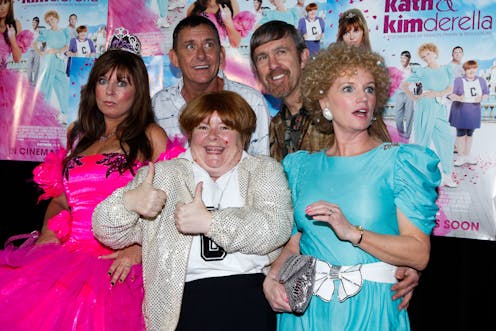Noice. Different. Unusual. Watching Kath and Kim as a (locked down) historian
- Written by Michelle Arrow, Professor of History, Macquarie University

Our writers nominate the TV series keeping them entertained during a time of COVID.
In our household, watching comedy in the evenings has been a crucial part of our lockdown survival strategy. We powered through a lot of comedy series last year, and watched some more than once. (I’m looking at you, Schitt’s Creek). Stuck in lockdown for the foreseeable future, I suggested we might re-watch those Fountain Gate foxymorons, Kath and Kim, and my 12-year-old daughter’s eyes lit up.
She’s not alone. When Netflix added Kath and Kim to its service in 2019, it introduced the show to a generation born well after its early 2000s heyday. Its renewed popularity has spawned Tik Tok[1] challenges and Instagram fan accounts. The resurgence of 80s fashion (especially so-called “mum jeans”) means many Gen Z’s[2] share Kath’s fondness for a “foot-long fly” and acid wash denim.
A suburban sitcom about Kath Day, that “high maintenance” foxy lady, her “hornbag” daughter Kim, and Kim’s “second best friend” Sharon Strezlecki, Kath and Kim remains one of Australia’s best loved comedy series. Premiering in 2002 on the ABC, it was the top-rating[3] series on television in 2003-2004.
Creators Jane Turner and Gina Riley moved to Channel 7 for the show’s final season in 2007, and produced a telemovie, Da Kath and Kim Code (2005) and a feature film, Kath and Kimderella (2012).
For decades, Australian television comedy typically relegated women to the sidelines, as objects to ogle or as sidekicks to male characters. Kath and Kim was an amazing showcase for Riley, Turner and Magda Szubanski. The male performers (Peter Rowsthorn and Glenn Robbins) are terrific but the women are the stars.
The trio were popular cast members of the late 1980s Channel 7 comedy series Fast Forward, revealing a talent for parodying media culture, precise observations of Australian women’s speech, and an utter lack of vanity. Kath, Kim and Sharon’s characters first appeared in a series of sketches called “Kim’s Wedding” in their comedy series Big Girl’s Blouse[4], which ran for a single season in 1994.
Big Girl’s Blouse was ground-breaking because it emerged from a female, even feminist[5] perspective. In Midweek Ladies[6], a brilliant “documentary” about the leadership turmoil in a ladies tennis club, the trio parodied the self-seriousness of men’s political machinations on the national stage, while also hinting at smaller but no less meaningful dramas playing out in women’s lives across Australia.
Female-centred satire
Australian culture has a long history of satirising, or looking down on, suburbia. From Robin Boyd’s Australian Ugliness to Barry Humphries’s Mrs Edna Everage, many of these critiques were created by men.
Riley and Turner understood the broad appeal of poking fun at suburbia, the place where so many of us grew up. Their humour is broad and specific (or “pacific”, as Kath would say) at the same time, but it always emanated from a keenly observed, female perspective. Only women of a certain age and class could make a joke about Kim being a “Country Road size ten”.
Among the bigger comedic moments (Kath’s wedding, any scene featuring Kath and Kel’s dancing) were dozens of small, well observed details: the squeaky back door of Kath’s house, or Kath sneaking extra rubbish into her neighbour’s bins.
Kath and Kim has endured partly because of its quotable scripts and catchphrases. Most of us like to imagine we’re more sophisticated than we really are, and it is this gap between self-perception and reality that fuels Kath and Kim’s malapropisms.
Read more: The horror and pleasure of misused words: from mispronunciation to malapropisms[7]
Kath announces her engagement by telling Kim that “Kel and I have decided to make our beautiful, sensual relationship a mere formality”; Kim decides she will spend some time “sowing her rolled oats” rather than return to her husband, Brett.
As an historian, I find the show fascinating for its commentary on what Hugh Mackay[8] called the “dreamy period” of the early 2000s, when a combination of increasing prosperity and anxiety about security meant
Australians […] disengaged from the issues that had been preoccupying them; they shut down, or at least went into retreat.
When Kath and Kim was at the peak of its ratings success in 2003, it was jostling with renovation reality shows, The Block and Backyard Blitz. It was also the era of Big Brother and Australian Idol, and the last gasp of tabloid magazine culture before it was swallowed up by the internet.
Class and ‘effluence’
Kath and Kim were true to the spirit of the Howard era in their aspirations to be, in Kim’s words, “effluent”. As she tells her daughter,
you are effluent, Kim. I mean look at what you’ve got, a Hyundai to hightail it round in, a half share in a home unit, a DVD player, a mobile. I mean, what else is there?
Yet the series not only poked fun at “aspirationals”, but at the wealthy as well. Prue and Trude, the grey-bobbed homewares store employees, with “jojoba leftover from October”, highlighted the myth of Australia’s “classless” society.
In 2021, with our horizons reduced by COVID lockdowns and more time spent at home, perhaps the tiny domestic dramas of Kath and Kim (“that was my last fat-free fruche, Sharon!”) are a little more relatable than they used to be.
Certainly, my daughter and I have had time to work on our Kath and Kim impersonations. That’s noice, different, unusual.
Kath and Kim is streaming on Netflix.
References
- ^ Tik Tok (www.tiktok.com)
- ^ Gen Z’s (www.wmagazine.com)
- ^ top-rating (www.screenaustralia.gov.au)
- ^ Big Girl’s Blouse (www.youtube.com)
- ^ feminist (dailyreview.com.au)
- ^ Midweek Ladies (www.youtube.com)
- ^ The horror and pleasure of misused words: from mispronunciation to malapropisms (theconversation.com)
- ^ Hugh Mackay (www.hachette.com.au)

















